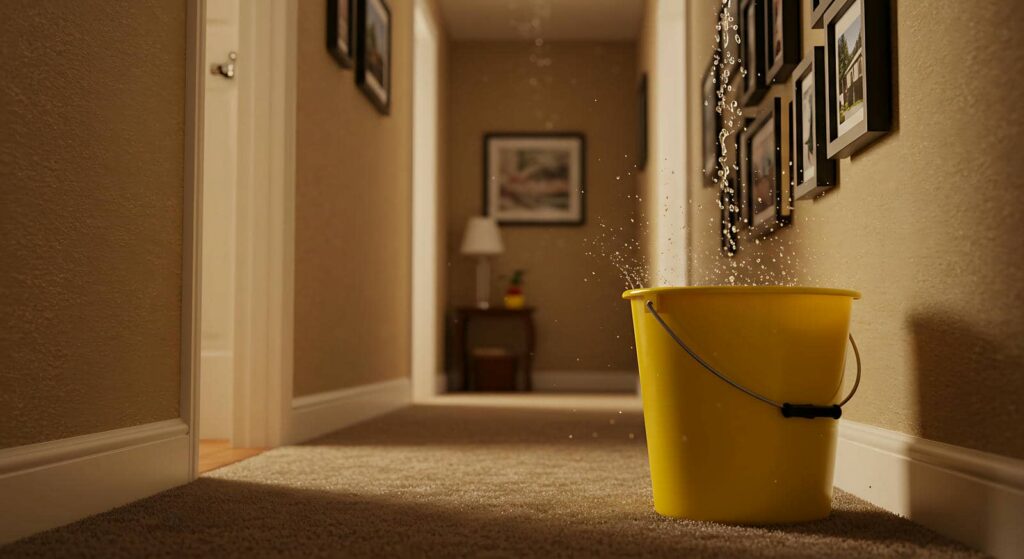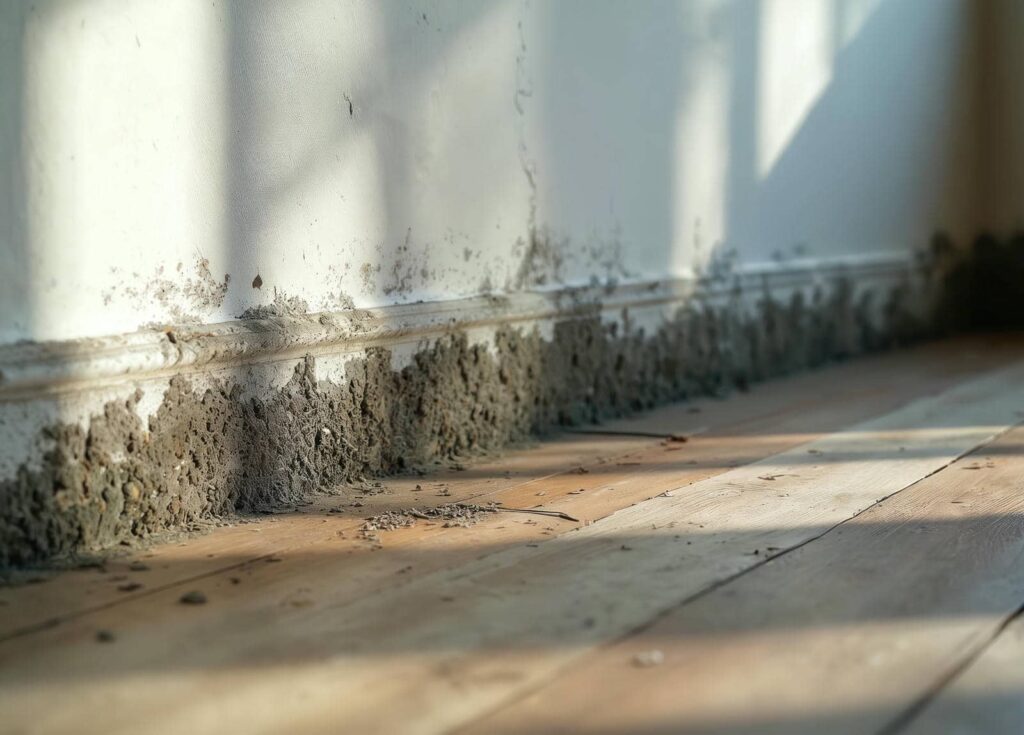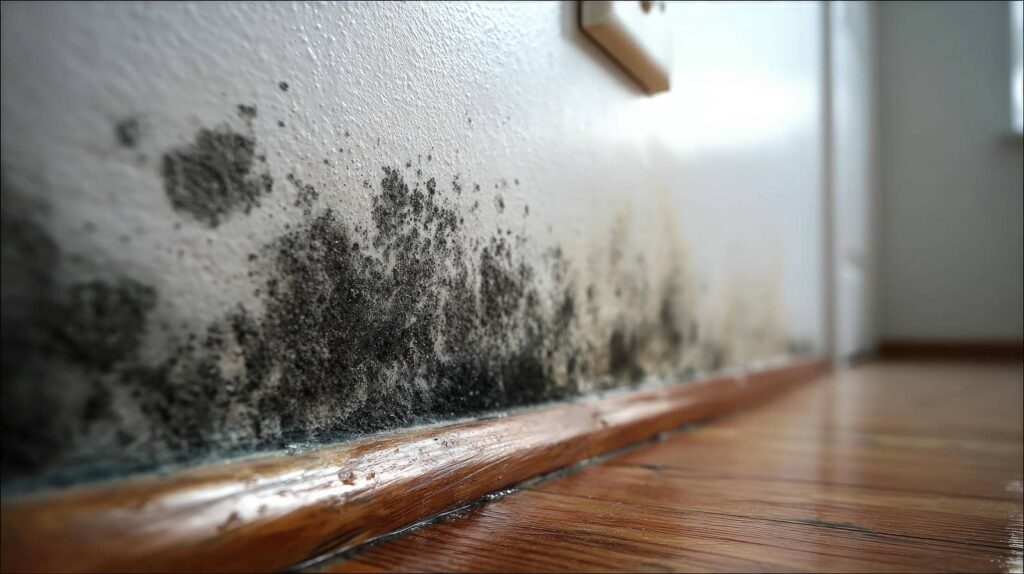Contents
When it comes to the safety of your home, staying vigilant about potential issues is key. Imagine a scenario where a leak in your roof goes unnoticed, causing gradual damage that could have been easily prevented. The consequences of such oversight can be far-reaching and expensive. Understanding the subtle signs that hint at undetected roof leaks is essential for early intervention. By being proactive and knowing what to look for, you can safeguard your home from serious structural damage. Stay tuned to uncover the telltale signs that may indicate a hidden leak demanding your immediate attention.
Key Takeaways
- Look for water stains on ceilings or walls.
- Inspect the attic for hidden leaks.
- Check for musty odors indicating mold.
- Examine insulation for wetness.
- Address leaks promptly to prevent damage.
Stained or Discolored Ceilings
When inspecting for roof leaks, look for stained or discolored ceilings, as they’re a clear indicator of water infiltration. Ceiling discoloration often reveals the presence of leaks that mightn’t be immediately visible. To effectively identify the source of the leak, start by examining the discolored areas for any signs of active water flow or dampness. This could help pinpoint the exact location of the leak and assist in determining the severity of the issue.
Leak detection requires a keen eye and a systematic approach. Begin by checking the attic or crawl spaces directly above the stained ceiling. Look for any signs of moisture, mold, or mildew, as these are common indicators of a roof leak. Additionally, inspect the roof itself for missing, damaged, or deteriorating shingles, as these can be entry points for water.
Peeling Paint or Wallpaper
If you notice paint bubbling on your walls, it could be a sign of underlying moisture issues.
Discolored wallpaper may indicate water infiltration in your walls.
Peeling paint near the ceiling often reveals a leak from the roof that needs immediate attention.
Paint Bubbling Indicates Moisture
Paint bubbling on your walls or ceiling is a clear indicator of underlying moisture issues that require immediate attention. When paint or wallpaper starts to bubble, it is often a sign of water damage or excessive moisture present in the walls. This can be caused by various factors, such as leaking pipes, roof issues, or high humidity levels. Addressing the source of the moisture is vital to prevent further damage to your property. Below is a table summarizing the possible causes and solutions for paint bubbling due to moisture:
| Possible Causes | Recommended Actions |
|---|---|
| Leaking Roof | Inspect and repair roof leaks |
| Plumbing Issues | Fix any leaking pipes or fixtures |
| High Humidity Levels | Use dehumidifiers to control humidity |
Wallpaper Discoloration Signals Water
Experiencing wallpaper discoloration can serve as a warning sign of water infiltration, specifically through peeling paint or wallpaper. When moisture seeps into the walls, the wallpaper loses its adhesive properties, resulting in unsightly discoloration and peeling. This visible damage is a clear indicator of potential water damage within the wall structure. Detecting such signs early is vital for preventing further deterioration and costly repairs.
Peeling Near Ceiling Reveals Leak
Peeling near the ceiling often serves as a visible indicator of a potential leak, whether through peeling paint or wallpaper. This issue can be a result of water seepage from the roof, causing the paint or wallpaper to lose adhesion and peel off. To address this, a thorough roof inspection and moisture detection are important steps to pinpoint the source of the leak accurately. Here’s a helpful table outlining key actions for dealing with peeling near the ceiling:
| Actions to Take | Description |
|---|---|
| Roof Inspection | Check for missing shingles, cracks, or damaged flashing. |
| Moisture Detection | Use moisture meters to identify water presence in the affected area. |
| Repair Roof | Fix any identified issues promptly to prevent further leaks. |
| Repaint or Replace | Once the roof is fixed, repaint or replace the affected area. |
Musty Odors Indoors
If you detect a musty odor indoors, it could indicate the presence of mold or mildew resulting from a roof leak. Identifying the source of the odor is vital to addressing the issue promptly and preventing further damage.
Additionally, musty odors indoors can pose health risks, making it essential to resolve the underlying problem swiftly.
Indoor Musty Smell
The presence of an indoor musty smell often indicates a potential issue with moisture and mold growth within the structure. Moisture detection is vital in promptly addressing this concern. Excess moisture can lead to mold development, affecting indoor air quality and potentially causing health issues.
To improve indoor air quality and eliminate musty odors, identifying and rectifying the moisture source is essential. Common culprits include roof leaks, plumbing issues, or poor ventilation. Regular inspections and maintenance can help prevent these problems.
If you notice a musty smell indoors, consider consulting a professional to assess the extent of moisture damage and mold growth. Taking swift action can safeguard your health and preserve the integrity of your living environment.
Source of Odor
To pinpoint the source of musty odors indoors, investigate potential moisture issues such as roof leaks, plumbing problems, or inadequate ventilation. Utilize odor detection methods to narrow down the cause.
Start by checking for any visible signs of leaks or water damage on the roof, ceilings, or walls. Identifying hidden leaks may require a professional inspection using specialized tools like moisture meters.
Pay attention to areas with poor ventilation, as stagnant air can trap moisture and create a breeding ground for mold and mildew, resulting in unpleasant odors. Addressing these underlying issues promptly can help eliminate the musty smell and prevent further damage to your home.
Health Concerns
When detecting musty odors indoors, prioritize addressing potential health concerns associated with mold and mildew growth. Mold exposure risks from undetected roof leaks can lead to serious health issues.
The presence of mold spores in the air can affect indoor air quality, triggering respiratory problems like coughing, wheezing, or exacerbating asthma symptoms. If left unaddressed, mold can spread rapidly, causing structural damage and posing significant health risks to you and your family.
Keep a keen eye (and nose) out for any musty odors, as they could be indicative of a hidden leak. Promptly addressing these issues guarantees a healthier indoor environment and prevents further damage to your home.
Sagging or Warped Walls
Wondering why your walls are sagging or warped can indicate an important roof leak that needs immediate attention. Sagging or warped walls suggest a compromise in wall stability, possibly due to structural damage caused by water infiltration. When a roof leak goes unnoticed, water can seep into the walls, weakening their structural integrity over time. This moisture weakens the materials, leading to warping or sagging as they lose their ability to support the weight above.
To address this issue, it’s vital to inspect the roof thoroughly for any signs of leakage. Look for missing or damaged shingles, deteriorated flashing, or clogged gutters that could be allowing water to seep into the walls. If left unattended, sagging or warped walls can pose serious safety risks and lead to costly repairs. Promptly fixing the roof leak and addressing any structural damage will help restore the stability of your walls and prevent further deterioration. Remember, addressing roof leaks promptly is key to maintaining a safe and structurally sound home.
Mold or Mildew Growth
A musty or damp odor permeating your home could be a warning sign of mold or mildew growth due to a roof leak.
Mold and mildew not only compromise the structural integrity of your home but also pose serious health risks to you and your family.
Addressing roof leaks promptly is essential in preventing the spread of mold and safeguarding your health and property.
Damp Odor Warning
Upon entering a room with a musty smell, you may be detecting an early warning sign of mold or mildew growth caused by roof leaks. Damp odors often indicate the presence of excess moisture, providing a vital environment for mold and mildew to thrive. To prevent further growth, it’s essential to promptly address roof leaks.
Regular maintenance checks, such as inspecting the roof for damaged shingles or gaps, can help in identifying potential leak sources before they escalate. Additionally, ensuring proper ventilation and controlling indoor humidity levels can discourage mold and mildew development.
Health Risks Associated
Detecting mold or mildew growth due to roof leaks poses significant health risks that demand immediate attention. Mold exposure resulting from undetected roof leaks can lead to severe respiratory issues if left unchecked.
The presence of mold or mildew signifies a moisture problem that requires prompt resolution to prevent further health complications. Mold spores released into the air can exacerbate allergies, trigger asthma attacks, and cause respiratory distress.
Addressing roof leaks promptly is essential in mitigating the risks associated with mold exposure and safeguarding the health and well-being of occupants. If you suspect mold growth due to roof leaks, it’s essential to take swift action to eliminate the source of moisture and engage in proper remediation to prevent any adverse health effects.
Dripping or Water Stains
When observing dripping water or water stains on your ceiling, act promptly to address potential roof leaks. These signs often indicate underlying issues that require immediate attention to prevent further water damage to your property.
Here are some essential steps to take when faced with dripping or water stains:
Inspect Your Roof: Conduct a thorough roof inspection to identify the source of the leak accurately.
Check for Damaged Shingles: Look for any missing, cracked, or damaged shingles that could be allowing water to seep through.
Clear Debris: Remove any debris, such as leaves or branches, that may be blocking proper drainage on your roof.
Contact a Professional: If you’re unable to locate or fix the leak yourself, seek help from a roofing professional to assess and repair the issue promptly.
Taking swift action when noticing dripping water or water stains can help mitigate further damage and potentially save you from costly repairs down the line.
Increased Energy Bills
If you notice a sudden increase in your energy bills, it could be a sign of potential issues with your roof that need to be addressed promptly. A well-maintained roof plays an important role in the energy efficiency of your home. Damaged or leaking roofs can lead to heat loss during the colder months and cool air loss during the warmer months, causing your heating and cooling systems to work harder and longer to maintain a comfortable temperature. This increased workload can have a major impact on your utility costs, resulting in higher energy bills.
To guarantee energy efficiency and lower utility costs, it’s essential to promptly address any roof leaks or damage. By fixing these issues in a timely manner, you can prevent further energy loss and reduce the strain on your heating and cooling systems. Regular roof inspections and maintenance are key to preserving the integrity of your roof and safeguarding your home’s energy efficiency. Remember, investing in your roof’s health today can lead to long-term savings on your utility bills.
Visible Exterior Damage
Examine your roof’s exterior for any visible damage that may indicate potential leaks requiring immediate attention. Conducting a thorough roof inspection is vital in identifying issues early on before they escalate.
Here are four key signs of visible exterior damage that could point to underlying roof leaks:
Missing or Damaged Shingles: Look out for any shingles that are cracked, curled, or completely missing. These can leave your roof vulnerable to water infiltration.
Clogged Gutters: Check for debris buildup in your gutters, as this can prevent proper drainage and lead to water pooling on your roof.
Flashing Issues: Inspect the flashing around chimneys, vents, and skylights for signs of damage or deterioration, as compromised flashing can allow water to seep into your home.
Sagging Roof Sections: Notice any areas where the roof appears to be sagging or dipping, as this could indicate water damage and potential structural issues.
Regularly monitoring your roof for these visible exterior damages can help you catch leaks early and prevent further water damage to your home.
Soft or Wet Insulation
Examining your roof for soft or wet insulation is vital in identifying potential leaks that require immediate attention. Insulation damage can occur due to various factors, including water infiltration from roof leaks. When insulation gets wet, it loses its effectiveness, leading to energy loss and potential mold growth. Moisture detection is essential in pinpointing areas where leaks might be present. Here is a table to help you understand the signs of soft or wet insulation:
| Signs of Soft or Wet Insulation | ||
|---|---|---|
| High energy bills | Musty odors in the house | Visible water stains on ceiling |
| Mold growth | Sagging ceiling or walls | Increased indoor humidity levels |
Pest Infestations
Regularly inspecting your roof for signs of pest infestations is crucial to maintaining its structural integrity and preventing potential damage. Pest infestations can lead to roof leaks and compromise the safety and comfort of your home. To effectively manage pest infestations and prevent further issues, consider the following maintenance tips:
Trim Trees and Vegetation: Overhanging branches can provide easy access for pests to your roof. Trim trees and vegetation to reduce the likelihood of pests finding their way onto your roof.
Seal Entry Points: Inspect your roof for any gaps, cracks, or openings that pests could use to enter your home. Seal these entry points to prevent infestations.
Maintain Gutters: Clogged gutters can attract pests looking for water sources. Keep your gutters clean and free of debris to deter pests from congregating near your roof.
Professional Pest Control: Consider hiring a professional pest control service to regularly inspect and treat your home for pests, especially if you notice signs of infestation or damage to your roof.
Wrap-Up
As you take the time to inspect your home for signs of roof leaks, remember that prevention is crucial to protecting your investment. By addressing any issues promptly, you can avoid costly repairs and maintain a safe living environment for you and your loved ones.
Stay vigilant and proactive in maintaining your home to ensure peace of mind and avoid unexpected surprises. Your diligence today can save you from headaches tomorrow.




